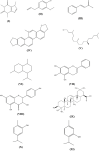Review on Plant-Based Management in Combating Antimicrobial Resistance - Mechanistic Perspective
- PMID: 36249774
- PMCID: PMC9557208
- DOI: 10.3389/fphar.2022.879495
Review on Plant-Based Management in Combating Antimicrobial Resistance - Mechanistic Perspective
Abstract
Antimicrobial resistance (AMR) occurs when microbes no longer respond to any pharmacological agents, rendering the conventional antimicrobial agents ineffective. AMR has been classified as one of the top 10 life-threatening global health problems needed multilevel attention and global cooperation to attain the Sustainable Development Goals (SDGs) according to the World Health Organization (WHO), making the discovery of a new and effective antimicrobial agent a priority. The recommended treatments for drug-resistant microbes are available but limited. Furthermore, the transformation of microbes over time increases the risk of developing drug resistance. Hence, plant metabolites such as terpenes, phenolic compounds and alkaloids are widely studied due to their antibacterial, antiviral, antifungal and antiparasitic effects. Plant-derived antimicrobials are preferred due to their desirable efficacy and safety profile. Plant metabolites work by targeting microbial cell membranes, interfering with the synthesis of microbial DNA/RNA/enzymes and disrupting quorum sensing and efflux pump expression. They also work synergistically with conventional antibiotics to enhance antimicrobial effects. Accordingly, this review aims to identify currently available pharmacological therapies against microbes and AMR, as well as to discuss the importance of plant and secondary metabolites as a possible solution for AMR together with their mechanisms of action. All the information was obtained from government databases, WHO websites, PubMed, Springer, Google Scholar and Science Direct. Based on the information obtained, AMR is regarded as a significant warning to global healthcare. Plant derivatives such as secondary metabolites may be considered as potential therapeutic targets to mitigate the non-ending AMR.
Keywords: antimicrobial resistance; bacteria; fungi; parasites; plants; secondary metabolites; virus.
Copyright © 2022 Arip, Selvaraja, R, Tan, Leong, Tan, Yap, Chinnapan, Tat, Abdullah, K and Jubair.
Conflict of interest statement
The authors declare that the research was conducted in the absence of any commercial or financial relationships that could be construed as a potential conflict of interest.
Figures




References
-
- Abbas M., Saeed F., Anjum F. M., Afzaal M., Tufail T., Bash M. S., et al. (2017). Natural polyphenols: An overview. Int. J. Food Prop. 20, 1689–1699. 10.1080/10942912.2016.1220393 - DOI
-
- Abdallah L., Omar G. (2019). Antibacterial effect of some wild medicinal plants in Palestine against multidrug resistant Escherichia coli clinical isolate. Braz. J. Biol. Sci. 6, 103–113. 10.21472/bjbs.061209 - DOI
-
- Ahmed S., Ning J., Cheng G., Maan M. K., Chen T., Ahmad I., et al. (2020a). Development and validation of an enzyme-linked receptor assay based on mutant protein I188K/S19C/G24C for 40 beta-lactams antibiotics detection in 13 food samples. Microchem. J. 152, 104354. 10.1016/j.microc.2019.104354 - DOI
Publication types
LinkOut - more resources
Full Text Sources
Molecular Biology Databases

